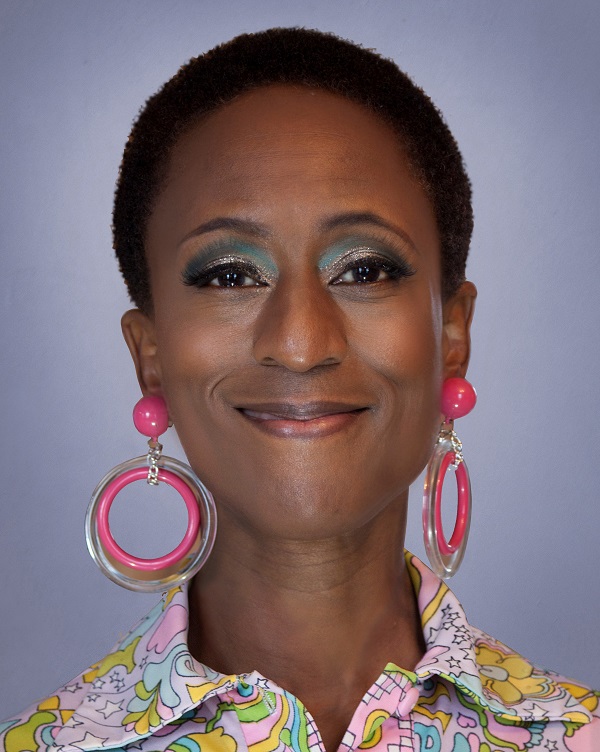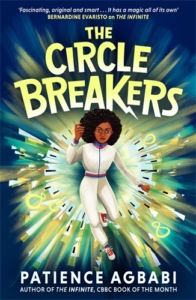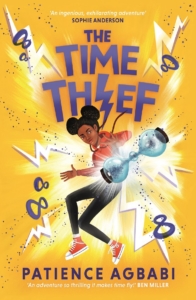
Taking a Leap: an interview with Patience Agbabi
Fiona Noble talks to award-winning poet Patience Agbabi about her new series for young readers, The Leap Cycle.
 In 2014, Patience Agbabi’s Telling Tales was published, a 21st century remix of Chaucer’s Canterbury Tales. Longer in form and more focused on character and story than her earlier work, Patience found herself struggling to reengage with her usual creative medium of poetry. Then, the character of a young girl came into her head. ‘I couldn’t get rid of her,’ she recalls, talking to me over video call from her home. This was to be Elle Bibi-Imbelé Ifiè, the heroine of The Leap Cycle, Patience’s first series for children, which continues this January in the third instalment, The Circle Breakers. The early Elle, Patience explains, ‘is very much based on me. I went back to my childhood and found all this stuff I wanted to talk about.’ Elle adores language and writing but her other love is athletics and the American long jump athlete Bob Beamon, known for his record-breaking leap at the 1968 Olympics. ‘The poet in me was obsessed with that word leap,’ Patience laughs, which lead her to the idea of children born on leap years being in possession of a special gift. ‘Wouldn’t it be really exciting if she could leap through time?’
In 2014, Patience Agbabi’s Telling Tales was published, a 21st century remix of Chaucer’s Canterbury Tales. Longer in form and more focused on character and story than her earlier work, Patience found herself struggling to reengage with her usual creative medium of poetry. Then, the character of a young girl came into her head. ‘I couldn’t get rid of her,’ she recalls, talking to me over video call from her home. This was to be Elle Bibi-Imbelé Ifiè, the heroine of The Leap Cycle, Patience’s first series for children, which continues this January in the third instalment, The Circle Breakers. The early Elle, Patience explains, ‘is very much based on me. I went back to my childhood and found all this stuff I wanted to talk about.’ Elle adores language and writing but her other love is athletics and the American long jump athlete Bob Beamon, known for his record-breaking leap at the 1968 Olympics. ‘The poet in me was obsessed with that word leap,’ Patience laughs, which lead her to the idea of children born on leap years being in possession of a special gift. ‘Wouldn’t it be really exciting if she could leap through time?’
The Leap Cycle begins in The Infinite where we meet 12 year-old Elle. Born on the 29th February, Elle is a Leapling with the rare gift of being able to jump through time and becomes part of a crime fighting, time travelling group of young people called The Infinites. Each book is a thrilling blend of time travel and mystery, pitching Elle and her friends against The Vicious Circle, an evil gang who sit in the order of a clock face and wreak havoc through time. In the first book she jumps to 2048 to investigate Leaplings going missing in time; The Time Thief sees her travel back to the 1790s to prove a friend’s innocence. In The Circle Breakers, Elle is now 14 years old. An anonymous person is threatening to expose the Leapling community to the media, which could have catastrophic global consequences. Elle and the other Infinites must travel to the 1880s to discover who is behind it. An emotional subplot also explores Elle’s relationship with her Nigerian grandmother.
The theme of time stretches through the book’s 24 chapters and even to publication dates: the first book was published in 2020, a leap year,  and the fourth and final book will, rather neatly, come out in the next leap year, 2024. Sticking to the book-a-year format which publishing demands of children’s series has proved testing at times. ‘The poet in me has found that challenging,’ she admits. ‘It’s a lot of words.’ The time travel itself, however, was more straightforward. ‘I conceptually can see another time just like another place.’ Patience and her editor decided early on to keep things relatively simple. In her tetralogy the past is fixed: nothing they do in the past can change the current present, but it could change the future. However, she adds, ‘people might think that they have found a way to change things. As a writer I’ve always been interested in temporality and the emotional pull it has. I’ve always found it interesting how you can play around with time not being linear.’
and the fourth and final book will, rather neatly, come out in the next leap year, 2024. Sticking to the book-a-year format which publishing demands of children’s series has proved testing at times. ‘The poet in me has found that challenging,’ she admits. ‘It’s a lot of words.’ The time travel itself, however, was more straightforward. ‘I conceptually can see another time just like another place.’ Patience and her editor decided early on to keep things relatively simple. In her tetralogy the past is fixed: nothing they do in the past can change the current present, but it could change the future. However, she adds, ‘people might think that they have found a way to change things. As a writer I’ve always been interested in temporality and the emotional pull it has. I’ve always found it interesting how you can play around with time not being linear.’
One of the most striking elements of The Leap Cycle is its representation of autistic characters. ‘I couldn’t have a heroine who wasn’t neurodivergent,’ Patience tells me. ‘It just seemed very natural.’ Because she is not personally diagnosed as autistic, Patience works closely with autistic sensitivity reader Lizzie Huxley-Jones. ‘She reads everything very early on and gives feedback. She’s very helpful and positive.’ Patience wanted to reflect the world she saw around her so the diverse cast features several other neurodivergent characters, including MC², who has ADHD, and Big Ben, whose autism manifests very differently to Elle’s. ‘Autism is a spectrum and neurodiversity is even broader. I thought it very important to represent this,’ she says. Breaking through stereotypes was also key. Rather than a mathematically gifted character Patience opted for a heroine who is very linguistically intelligent. Elle is also a Black autistic girl, something Patience had been unable to find in other middle grade books.
In writing about time travel, Patience has had to create a vision of the future. The world we see in her 2048 may be impacted by climate change but it feels less dark than many other futuristic children’s books. There is a positive energy at play, of people trying to find solutions through a more carbon neutral, meat-free society. ‘It’s very important to give young people hope,’ Patience stresses. ‘The idea is that what we do now will affect the future. The idea of being responsible, a sense that everything we do has some kind of impact. In a way it’s an exciting message because we could create a really good future. It could be utopian; it doesn’t have to be dystopian.’
Fiona Noble is a books journalist and reviewer, specialising in children’s and YA literature, for publications including The Bookseller and The Observer.
The Infinite, Canongate Books, 9781786899651, £7.99, pbk
The Time Thief, Canongate Books, 9781786899903, £7.99, pbk
The Circle Breakers, Canongate Books, 9781838855796, £7.99, pbk




